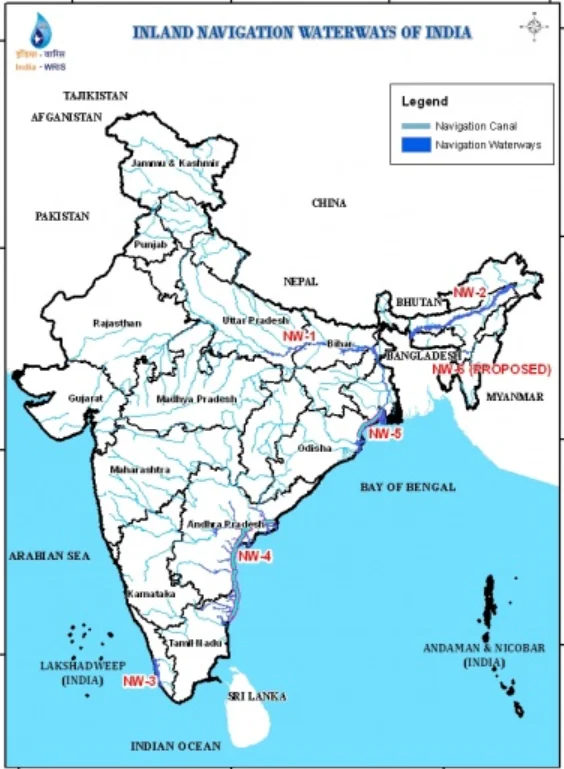In India, the vast network of inland waterways spans over 14,500 kilometers, consisting of rivers, canals, and backwaters. Established in 1986, the Inland Waterways Authority of India (IWAI) regulates and develops these water routes for shipping and navigation, aiming to alleviate pressure on railways and roads. With 111 waterways declared as National Waterways under the National Waterways Act of 2016, efforts are underway to revitalize this eco-friendly and cost-effective mode of transport.
Overview of India’s Navigable Waterways and Inland Water Transport (IWT)
- India’s Navigable Waterways: India has approximately 14,500 km of navigable waterways, comprising rivers, canals, backwaters, and creeks.
- Infrastructure Development: for waterways includes fairways, navigational aids, and terminals.
- Declaration of National Waterways: The National Waterways Act, 2016, effective from April 12, 2016, declared 111 waterways as National Waterways, promoting Inland Water Transport (IWT).

-
- Out of these, 25 waterways were found viable for cargo/passenger movement, with development initiated in the first 13.
- Regulation: Inland Waterways Authority of India (IWAI) regulates National Waterways safety through regulations like Prevention of Collision and Safety of Navigation.
- Inland Water Transport (IWT) moves around 55 million tonnes of cargo annually in an eco-friendly manner.
- Concentration of IWT Operations: IWT operations are concentrated in certain areas like the Ganga-Bhagirathi-Hooghly River, Brahmaputra, Barak River, rivers in Goa, backwaters in Kerala, and inland waters in Mumbai.
- Maintenance of Waterways: varies depending on their characteristics, such as tidal canals and alluvial rivers
- Inland Vessels Act: The Inland Vessels Act, 2021, replaced the 1917 Act, ensuring uniform rules for inland navigation, prioritizing safety.
| Waterways |
Stretch |
| NW-1 |
Allahabad-Haldia stretch (1,620 km); Uttar Pradesh, Bihar, Jharkhand, West Bengal |
| NW-2 |
Sadiya-Dhubri stretch (891 km); Assam |
| NW-3 |
Kottapuram-Kollam stretch; Kerala; west coast canal along with Champakara canal (14 km) and Udyogmandal canal |
| NW-4 |
Specified stretches of Godavari and Krishna rivers along with Kakinada Puducherry stretch of canals (1078 km); Andhra Pradesh |
| NW-5 |
Specified stretches of river Brahmani along with Matai river, delta channels of Mahanadi and Brahmani rivers and East Coast canals. |
| NW-6 |
Barak River (121 km) |
The Evolution and Role of Inland Water Transport in India
- Historical Significance: Inland Water Transport (IWT) is an eco-friendly and cost-effective mode of transportation, needing initial public funding to attract private investment.
- Historically, IWT was vital for trade until railways and roads overshadowed it.
- Establishment of IWAI: The establishment of the Inland Waterways Authority of India (IWAI) in 1986 aimed to regulate and develop inland waterways.
- India has about 14,500 km of navigable waterways which consist of rivers, canals, backwaters, creeks, etc.
- 111 waterways (including 5 existing and 106 new) have been declared as National Waterways (NWs) under the National Waterways Act, 2016.
- IWAI’s Mandate and Activities: WAI focuses on infrastructure development, feasibility studies, and advising the central government on IWT matters, supporting state-level IWT sector development.
Jurisdiction of Central and State Governments over Waterways: Constitutional provisions dictate that only waterways designated as National Waterways fall under the jurisdiction of the Central Government, while others fall under the respective State Governments.
- Since the establishment of IWAI, five waterways have been declared as National Waterways, namely:
- Ganga
- Brahmaputra
- West Coast Canal
- Kakinada-Puducherry Canals
- East Coast Canal
- The Barak river is currently under consideration by the Central Government for declaration as a National Waterway.
Criteria For Declaring A National Waterway
- The National Transport Policy Committee (1980) outlined criteria for declaring a national waterway.
- Navigation Capability: Capable of navigation by mechanically propelled vessels of a reasonable size.
- Width And Depth: A channel width of about 45 meters and a minimum depth of 1.5 meters.
- Continuous Stretch: of at least 50 kilometers, with exceptions for urban areas and intra-port traffic.
- Inter-State Connectivity: Serving the interests of multiple states or connecting a vast hinterland and major ports.
- Strategic Importance: Passing through strategic regions for national security logistic support or connecting areas underserved by other transport modes.
Conclusion
Inland Water Transport (IWT) holds immense potential as a fuel-efficient and environmentally friendly alternative to traditional modes of transportation. Through the systematic development of waterways and infrastructure by the IWAI, supported by public funding, India can harness the benefits of IWT to facilitate trade, commerce, and regional connectivity, paving the way for sustainable economic growth and reduced logistical burdens.
![]() May 9, 2024
May 9, 2024
![]() 2672
2672
![]() 0
0
